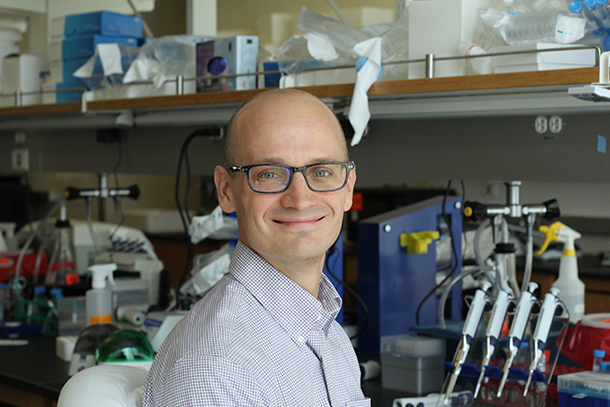For Joseph T. Rodgers, PhD, the path to becoming an assistant professor of stem cell biology and regenerative medicine at USC began in the woods of Ohio.
“My dad is a chemical engineer, and he’s always been an outdoorsy person,” Rodgers said. “You just go off in the woods and all that goes along with that — fishing, catching frogs and turtles. That was certainly how everything started.”
Rodgers double majored in biology and chemistry at the Jesuit-run John Carroll University. To this day, the philosophy of the Jesuits influences Rodgers, although he no longer considers himself formally religious.
“The main philosophy of the Jesuits is service,” he said. “My interpretation of service is expanding knowledge through research and education. That’s a main driving force of why I’m here today.”
He continued his commitment to expanding knowledge by attending graduate school at The Johns Hopkins University School of Medicine, where he earned a PhD in biochemistry, cellular and molecular biology.
Rodgers was the first graduate student in the laboratory of Pere Puigserver, PhD, who was just starting out. Together, they published a series of papers about metabolism.
When Puigserver moved his laboratory to Harvard Medical School, Rodgers followed to conduct postdoctoral research. He then completed a second postdoc in the laboratory of Tom Rando, MD, PhD, at the Stanford School of Medicine, where he began studying the signals the body uses to regulate stem cells’ metabolism and how this affects stem cells’ ability to make and repair tissue.
Recently, Rodgers’ team found that injury triggers the release of a molecule into the blood stream that puts stem cells throughout the body into a “high-alert” state, primed to repair and heal as needed. Eventually, doctors could prescribe some version of this molecule to patients before surgery, to soldiers before combat or to others likely to experience injury.
While he’s not in the laboratory, Rodgers likes gardening, doing aerial and acrobatic yoga, running marathons and participating in Ironman triathlons.
As a new assistant professor at USC, Rodgers is excited to continue uncovering the signals that instruct stem cells to build and repair tissue.
“This is a research area that’s ripe for somebody to tackle this question,” he said. “But also, I really hope to be an inspiring professor. There are a lot of really interesting things about science, and I just love this. And I hope to convey that to the students.”
— Cristy Lytal


